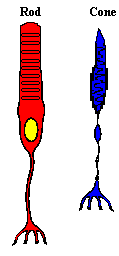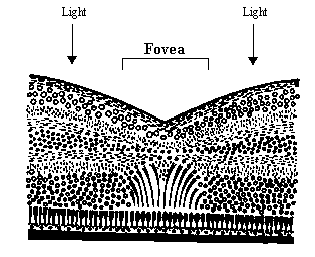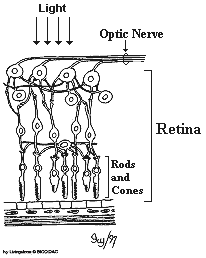The Retina
 The retina is the back part of the eye that contains the cells that respond to light. These specialized cells are called photoreceptors. There are 2 types of photoreceptors in the retina: rods and cones.
The retina is the back part of the eye that contains the cells that respond to light. These specialized cells are called photoreceptors. There are 2 types of photoreceptors in the retina: rods and cones.
The rods are most sensitive to light and dark changes, shape and movement and contain only one type of light-sensitive pigment. Rods are not good for color vision. In a dim room, however, we use mainly our rods, but we are "color blind." Rods are more numerous than cones in the periphery of the retina. Next time you want to see a dim star at night, try to look at it with your peripheral vision and use your ROD VISION to see the dim star. There are about 120 million rods in the human retina.
 The cones are not as sensitive to light as the rods. However, cones are most sensitive to one of three different colors (green, red or blue). Signals from the cones are sent to the brain which then translates these messages into the perception of color. Cones, however, work only in bright light. That's why you cannot see color very well in dark places. So, the cones are used for color vision and are better suited for detecting fine details. There are about 6 million cones in the human retina.
The cones are not as sensitive to light as the rods. However, cones are most sensitive to one of three different colors (green, red or blue). Signals from the cones are sent to the brain which then translates these messages into the perception of color. Cones, however, work only in bright light. That's why you cannot see color very well in dark places. So, the cones are used for color vision and are better suited for detecting fine details. There are about 6 million cones in the human retina.
 The fovea, shown here on the left, is the central region of the retina that provides for the most clear vision. In the fovea, there are NO rods...only cones. The cones are also packed closer together here in the fovea than in the rest of the retina. Also, blood vessels and nerve fibers go around the fovea so light has a direct path to the photoreceptors.
The fovea, shown here on the left, is the central region of the retina that provides for the most clear vision. In the fovea, there are NO rods...only cones. The cones are also packed closer together here in the fovea than in the rest of the retina. Also, blood vessels and nerve fibers go around the fovea so light has a direct path to the photoreceptors.
"Your vision is best when light falls on the fovea."
The "g" in "light" will be clear, but words and letters on either side of the "g" will not be clear.
One part of the retina does NOT contain any photoreceptors. This is our "blind spot". Therefore any image that falls on this region will NOT be seen. It is in this region that the optic nerves come together and exit the eye on their way to the brain.
To find your blind spot, look at the image below or draw it on a piece of paper:
Close your left eye.
Hold the image (or place your head from the computer monitor) about 20 inches away. With your right eye, look at the dot. Slowly bring the image (or move your head) closer while looking at the dot. At a certain distance, the + will disappear from sight...this is when the + falls on the blind spot of your retina. Reverse the process. Close your right eye and look at the + with your left eye. Move the image slowly closer to you and the dot should disappear.
Here is another image that will help you find your blind spot.
For this image, close your right eye. With your left eye, look at the red circle. Slowly move your head closer to the image. At a certain distance, the blue line will not look broken!!
No comments:
Post a Comment